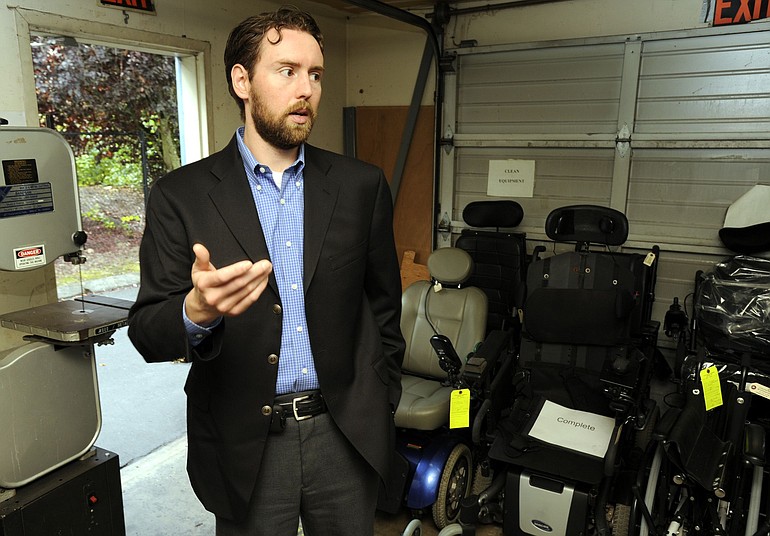Problems with a new statewide billing and payment system for Medicaid have plunged a 40-year-old, Portland-Vancouver area company into a bureaucratic ordeal that has sapped its revenue, led it to complain to elected officials and thrown its future in doubt.
And it’s not the only one. Across Washington state, critics of the new billing system believe that several hundred companies that provide medical equipment to patients have faced at least some problems.
Just how far-reaching those problems are remains a matter of dispute. State officials say problems are much more contained than frustrated business owners let on.
At issue is ProviderOne, the Washington Department of Social and Health Services’ complex new $164 million computerized system for handling millions in payments for medical and nursing home care to thousands of health care providers, including doctors and pharmacies.
Leaders of Portland-based Care Medical & Rehabilitation Equipment, whose Vancouver office represents about 20 percent of the company’s sales, said monthly revenue from Medicaid billings have dropped drastically because of glitches with ProviderOne. As a result, the company has been left with roughly $1.4 million in unpaid claims and mounting concerns over its ability to meet payroll and to serve customers. The company sells everything from wheelchairs to respiratory equipment.
“We’re profitable, but it’s a struggle every day,” said Angelene Adler, vice president of operations for Care Medical, which employs 350 people in Washington and Oregon.
Officials with DSHS see the situation differently. They said the system has worked exceedingly well for health care providers. While ProviderOne did have bugs early on and caused some problems for companies that provide medical equipment, the agency has fixed most of those problems and the majority of medical-equipment providers are now able to make the system work, said Heidi Robbins Brown, deputy state Medicaid director with DSHS. “From our perspective, ProviderOne has been exceptionally successful,” she said.
‘Learning curve’
ProviderOne problems appear to be limited only to equipment companies, and not the thousands of doctors, pharmacies and other medical providers using the state’s new billing and payment system.
It’s distributing $65 million to $70 million in weekly payments to health care providers, reflecting “normal levels of payment,” said Jim Stevenson, spokesman for DSHS. Stevenson said claims submitted by providers of medical equipment account for about 4.8 percent of the total fee-for-service dollars paid out.
Robbins Brown said Care Medical is “more of an outlier than the norm.” DSHS continues to work with Care Medical to figure out the system, Robbins Brown said, but “it really does seem to be, by and large, a learning curve on their part.”
Robert Lee, director of government affairs and health policy analyst for Care Medical, disagrees with that assessment of the situation. While DSHS is working hard to correct problems, including meeting with his company, Lee said, the notion that ProviderOne is running smoothly is wrong. Likewise, he said, the idea that Care Medical is alone in continuing to run into a faulty system and to lose revenue doesn’t hold water. As president-elect of the Pacific Association for Medical Equipment Services, which represents home medical equipment companies in Oregon and Washington, Lee said he’s hearing from a lot of companies whose bottom lines are hurting because of problems with ProviderOne.
“I’ve been having phone calls from many, many (medical equipment) providers who are planning on closing their doors permanently,” he said.
Wendell Matas, vice president of business development in the Pacific Northwest for Rocky Hill, Conn.-based ATG Rehab — a medical-equipment provider — said ProviderOne has been problematic, creating delays that at one point prevented his company from receiving as much as $350,000 in payments.
“It hurts our revenue, it hurts our work-force management and our customers don’t get what they need,” he said.
Years in development
After several years in development, DSHS launched the first phase of the ProviderOne system in May. It replaces a 32-year-old payment system for Medicaid, a shared state-federal health insurance program that serves low-income parents, children, seniors and people with disabilities. The new system software, built by Rockville, Md.-based CNSI, is intended to reduce errors, overpayment and fraud, and to reduce paperwork by offering user-friendly, online services. The federal government is paying for 90 percent of the cost of implementing the system and is expected to pick up roughly 75 percent of its operational costs.
The concerns raised by Care Medical and other businesses in Washington echo problems that occurred in 2005 with a troubled system CNSI built for Maine’s state government to process $1.5 billion in annual Medicaid claims and payments. That system’s hiccups triggered an “unusually high rate of rejected claims,” forcing several dentists and therapists to shutter their doors and turning away tens of thousands of Medicaid recipients, according to an April 2006 article in CIO Magazine, a publication for information technology executives, which extensively outlined Maine’s problems.
But DSHS officials say ProviderOne is exceeding expectations and performing well, with payment levels normal and only a small subset of businesses citing problems.
In 2012, DSHS expects to extend the same payment system to social programs.
Payments plummet
Robbins Brown said her department did extensive outreach to health care providers to help them with the new system and conducted thorough training and testing with 90 percent of those providers. During testing, Stevenson said, Care Medical submitted 25 claims, of which 16 were paid.
“Clearly, they still continued to have problems once we went live with filing claims,” Stevenson said.
Lee of Care Medical said that’s an understatement. Care Medical had no problems with DSHS’ former billing system, he said, but when ProviderOne went live “all hell broke loose.”
Before ProviderOne took effect, Care Medical brought in a monthly average of about $370,000 from its Medicaid billings, Lee said. After the new system went live, that monthly average plummeted to roughly $92,500 — a 75 percent decrease in just two months, he said.
DSHS staff has worked hard to fix problems and to release payments to Care Medical, Lee said. However, the ProviderOne software continues wrongfully sending his company’s billings into denial or suspension. “In some circumstances,” Lee said, “they don’t know where (billings) went.”
Lee said about 22 percent of Care Medical’s overall sales volume depends on successfully completing transactions with DSHS. He said the $1.4 million owed to the company is a conservative estimate because it doesn’t include a backlog of requests to provide equipment or services to patients that DSHS must review and approve before the billing process can begin.
Care Medical has taken its concerns about ProviderOne to Rep. Jim Moeller, D-Vancouver, and the Washington State Auditor’s Office. In a Sept. 21 e-mail to Jay Manning, chief of staff for Gov. Chris Gregoire, and Doug Porter, director of Medicaid for DSHS, Moeller wrote that Care Medical’s situation “is still critical” and he asked the state agency keep his office “informed of actions taken to resolve the situation.”
Robbins Brown said that over the past month and a half her agency met twice with as many as 22 representatives of medical-equipment companies to listen to their concerns and to address their problems. She said her agency has spent more time with Care Medical than any other medical-equipment provider to “help understand what’s preventing them from making accurate billings.”
Care Medical has worked hard to learn the new system and to iron out a few issues on its end, Lee said. But he believes ProviderOne and DSHS’ initial implementation of it are to blame for most of his company’s problems. Lee said there’s no doubt DSHS has spent more time with Care Medical to fix glitches, but that’s because the company is large enough to provide many different types of equipment, each of which require different billing and payment methods, leading to more opportunities for ProviderOne to mess things up.
“Obviously,” he said, “you’re going to hear from us.”




